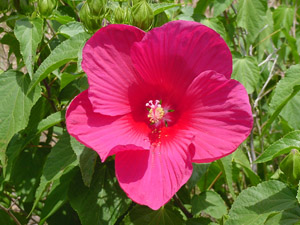Flare Hibiscus is Both Beautiful, Cold Hardy
By Norman Winter
MSU Horticulturist
Central Mississippi Research & Extension Center
A multitude of new plants have hit the market in recent years including one of my favorites, hibiscus. This hibiscus variety, Flare, is a wonderful cultivar that does great in any soil type. A perennial hibiscus variety, Flare has apple green foliage and large, high quality, fuchsia red flowers up to 10 inches wide. It stands 4 feet tall and is a profuse bloomer.
But what about the cold hardy, perennial types? In the last couple of years, companies such as Pan American Seed have introduced varieties like the Luna series. A few years ago, one special variety slipped under the radar, so to speak. It didn't get the recognition it deserved when released.
This hibiscus is called Flare. Flare was chosen as a Texas Superstar and was available in Mississippi garden centers. We bought some to try at our Mississippi Agricultural and Forestry Experiment Station in Crystal Springs. No one really knew much about it, and we figured it was kind of like any other perennial Hibiscus moscheutos or rose mallow. But it is not.
 Click to enlarge. |
The sawfly is a problem with many perennial hibiscus, causing their leaves to look like they have been blasted with a shotgun. The Flare may occasionally get a hole, but in our trials in Crystal Springs, it has been a stalwart performer for the past three years and worthy of all honors. When you look at a tropical hibiscus blooming on your deck or patio, it is easy to conjure up visions of the Caribbean and the sounds of a steel band.
It's funny how plants can mentally take us where neither our budget nor time will allow. Can a perennial hibiscus do the same? You bet your bottom dollar, especially if Flare is the variety. Think about how you can use perennial hibiscus in the tropical landscape. Create an exotic look with large bananas growing behind one of these shrubs, or plant a yellow bush form allamanda as a perfect companion.Hibiscus belong in the landscape whether combined with bananas, cannas or another tropical plant. Their requirements are much like those of other annuals.
Whether you choose the perennial or tropical types, plant in well-drained, well-prepared beds and use a good layer of mulch to keep the soil evenly moist through the season. Choose a site with plenty of sunlight. Morning sun and filtered afternoon light are just about perfect in our state. The hibiscus blooms on new growth, so it is important to keep it growing vigorously throughout the season. Keep them well fed and watered during droughty periods.
Many gardeners think that the prolific flower production of a hibiscus requires a lot of super bloom-type fertilizers high in phosphorous, but this is not the case. The hibiscus prefers a balanced fertilizer given out in regular small monthly applications.
Water daily if you are growing hibiscus or any other plant in containers during the summer. Nutrients quickly leach from the soil, so apply a dilute, water-soluble fertilizer weekly or add time-released granules per label recommendation. Chances are slim that youâll find the Flare this year (2005), but by all means ask your garden center to get them for you when possible. I know for a fact they are still being produced. It's nice when it is a cold hardy perennial that makes our landscape look like Montego Bay, Jamaica.